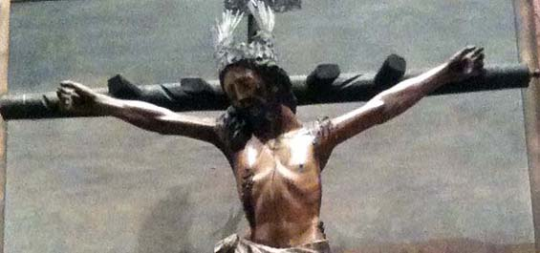
July 3rd, 2011 by alephnaught
Mission Buenaventura
We decided to rustle up the dogs and head to Ventura to check out the last mission close enough to us to easily drive to. Mission Buenaventura is near the coast in the City of Ventura about 45 minutes from us (with traffic though it took about one and a quarter hours to get there).
You enter the mission from the gift shop on Main; there’s a $2 fee and you get a map (the story of the mission from the map is reproduced below).
Here are some pictures from the mission:
Here is the text of the brochure:
The founding of San Buenaventura Mission was foreshadowed well over two centuries ago on the Spanish Isle of Mallorca, when a devout Franciscan priest, who was a brilliant scholar and professor of theology, : earnestly prayed that he might be permitted to forsake his comfortable circumstances to take up the Lord’s work among the aborigines in the New’ World. The hoped-for answer to his prayers came on Palm Sunday, March 30,1749.
Thirty-three years and one day later the zealous priest, Fray Junipero Serra – who had been subjected to painful sufferings and several brushes with death during his missionary ministry – raised the Cross at “la playa del canal de Santa Barbara” : (the beach of the Santa Barbara Channel) on Easter Morning, March 31, 1782. Assisted by Padre Pedro Benito Cambon, he celebrated a High Mass, preached on the Resurrection, and dedicated a Mission to San Buenaventura (Saint Bonaventure). It had been planned as the third in the chain of twenty-one Missions founded by Padre Serra but was destined to be the ninth and last founded during his lifetime, and one of six he personally dedicated.
Under the direction for Padre Cambon, whom Padre Serra left in charge of the new Mission, a seven-mile-long aqueduct was constructed to bring Ventura River water to the Mission. With plentiful water the Mission was able to maintain flourishing orchards and gardens, which were described by English navigator George Vancouver as the finest he had seen.
The Mission’s first church building, according to Vancouver, was destroyed by fire. The construction of a second church was abandoned because “the door gave way”. In 1792 work was in progress on the present church and the small utility buildings which (with the church) formed a quadrangle enclosing a plaza. Although half finished in 1795, the church was not completed until 1809. Dedication was held September 9 of that year and the first liturgical services took place September 10. At about that time the San Miguel Chapel (present corner of Thompson Boulevard and Palm Street) and the Santa Gertrudis Chapel (Highway 33 near Foster Park) were completed.
A series of earthquakes and an accompanying tidal wave in 1812 forced the padres: and Indian neophytes to seek temporary shelter a few miles inland. Six years later the padres and their flock had to remove sacred objects from the church and flee into the hills to elude a pirate who was pillaging the Missions but fortunately was : headed off after a “bargaining session” at El Refugio in Santa Barbara.
The Mexican government in 1834 issued a secularization decree divesting the padres of administrative control over the Mission. In 1845 San Buenavenrura Mission was rented to Don Jose Amaz and Narciso Botello and was later illegally sold to Amaz. After California became a state of the Union, Bishop Joseph Sadoc Alemany petitioned the United States Government to return that part of the Mission holdings comprising the church, clergy residence, cemetery, orchard, and vineyard to ‘the Catholic Church. The request was granted in the form of a Proclamation by President Abraham Lincoln on May 23, 1862.
Because of Severe earthquake damage in 1857 the Mission’s tile roof was replaced by a shingle roof. Some years later, in an effort to “modernize” the church, the windows were lengthened, the beamed ceiling and tile floor were covered, and the remnants of the quadrangle were razed. The west sacristy was removed to provide room for a school, which was not actually built until 1921. During the pastorate of Father Patrick Grogan the roof of die church was once again tiled, the convent and present rectory were built, and a new fountain was placed in the garden.
In major restoration under the supervision of Father Aubrey J. O’Reilly in 1956-1957, the windows were reconstructed to their: original size, and the ceiling and floor were uncovered. A long-time parishioner commissioned the casting of a bell with an automatic angelus device and donated it to the Mission, it hangs in the bell tower above the four ancient handoperated bells.
The entire roof of the church was removed and replaced in 1976. In December of that year the church was solemnly consecrated by Timothy Cardinal Manning. In 1982 the Mission marked its bicentennial anmversary.
Revisions:
There are no revisions for this post.




















4:16 pm on July 4th, 2011
Post: Mission Buenaventura http://www.alephnaught.com/Blo.....naventura/
Translate
12:28 am on January 1st, 2017
verry impressive
Translate
12:29 am on January 1st, 2017
very impressive
Translate